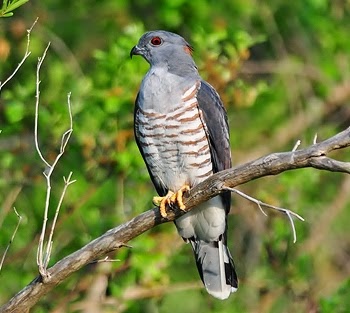 |
| (Photo from Planet of Birds) |
Common name:
African cuckoo-hawk (en); falcão-cuco-africano (pt); baza coucou (fr); baza africano (es); kuckucksweih (de)
Taxonomy:
Order Falconiformes
Family Accipitridae
Range:
This species is found in sub-Saharan Africa, from Senegal east to Ethiopia and south to Angola, northern Botswana, Mozambique and eastern South Africa.
Size:
These birds are 38-43 cm long and have a wingspan of 85-95 cm. They weigh 220-295 g.
Habitat:
The African cuckoo-hawk is found within and along the edges of dry tropical forests, also using dry savannas, plantations and even suburban gardens. They are present from sea level up to an altitude of 3.000 m.
Diet:
They feed on snakes, lizards and chameleons, large insects such as grasshoppers, mantids and caterpillars, as well as bees, wasps, termites alates, and small birds.
Breeding:
These birds breed can breed all year round, usually coinciding with the local rainy season. They are monogamous and both sexes help build the nest, an untidy platform made of sticks and leafy twigs, and lined with leaves. It is placed in a fork high in a tree, about 10-25 m above the ground. There the female lays 2-3 chalky-white eggs with reddish-brown spots, which are incubated by both parents for 32-33 days. The chicks fledge 30-42 days after hatching.
Conservation:
IUCN status – LC (Least Concern)
This species has an extremely large breeding range and is described as widespread. The population is suspected to be stable in the absence of evidence for any declines or substantial threats, but it may be affected by the loss of forest habitat and can be predated by larger raptors.







